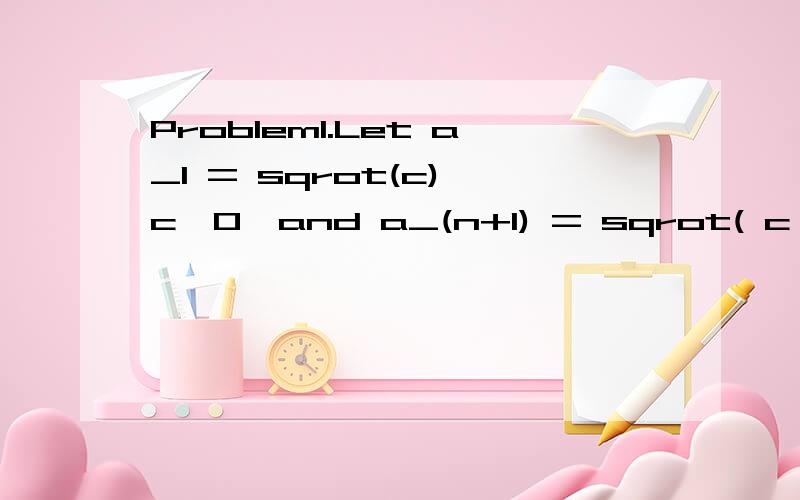Problem1.Let a_1 = sqrot(c),c>0,and a_(n+1) = sqrot( c + a_n),for n=1,2,3,...show that {a_n} is convergent and find the limit.Problem2.Show that the sequence s_n = ( 1 + 1/n )^n is monotone increasing and bounded.You may recall that its limit is the
来源:学生作业帮助网 编辑:作业帮 时间:2024/04/28 17:16:33

Problem1.Let a_1 = sqrot(c),c>0,and a_(n+1) = sqrot( c + a_n),for n=1,2,3,...show that {a_n} is convergent and find the limit.Problem2.Show that the sequence s_n = ( 1 + 1/n )^n is monotone increasing and bounded.You may recall that its limit is the
Problem1.
Let a_1 = sqrot(c),c>0,and a_(n+1) = sqrot( c + a_n),for n=1,2,3,...
show that {a_n} is convergent and find the limit.
Problem2.
Show that the sequence s_n = ( 1 + 1/n )^n is monotone increasing and bounded.You may recall that its limit is the number e.
Problem3.
a) If a_n > 0 for all n and lim a_n = s>0,then lim (a_1a_2 ...a_n)^(1/n) = s.
b) Show that lim [(n!)^1/n] /n = 1/e .
Problem1.Let a_1 = sqrot(c),c>0,and a_(n+1) = sqrot( c + a_n),for n=1,2,3,...show that {a_n} is convergent and find the limit.Problem2.Show that the sequence s_n = ( 1 + 1/n )^n is monotone increasing and bounded.You may recall that its limit is the
1.取b = (1+√(1+4c))/2,可验证√(c+b) = b.
易见a_1 = √c < b.
假设a_n < b,则a_(n+1) = √(c+a_n) < √(c+b) = b.
由数学归纳法可得a_n < b对任意正整数n成立.
故数列{a_n}有上界.
又{a_n}单调递增(参照a_3 = √(c+√(c+√c)) > √(c+√(c+0))) = √(c+√c) = a_2证明),
因此{a_n}存在极限,设为A.
对a_(n+1) = √(c+a_n)两边取极限得A = √(c+A).
解得A = (1+√(1+4c))/2 (负根舍去).
2.以C(n,k)记n中选k的组合数,即有C(n,k) = n(n-1)...(n-k+1)/k!.
s_n = (1+1/n)^n = 1+C(n,1)/n+C(n,2)/n^2+C(n,3)/n^3+...+C(n,n)/n^n
= 1+1+(1-1/n)/2!+(1-1/n)(1-2/n)/3!+...+(1-1/n)(1-2/n)...(1-(n-1)/n)/n!
≤ 1+1+1/2!+1/3!+...+1/n!
≤ 1+1+1/2+1/2^2+...+1/2^(n-1)
< 3,
故{s_n}有上界.
对s_(n+1) = (1+1/(n+1))^(n+1)类似上面进行展开,
s_(n+1) = 1+1+(1-1/(n+1))/2!+...+(1-1/(n+1))...(1-n/(n+1))/n!+1/(n+1)^(n+1).
与s_n相比要多出一项1/(n+1)^(n+1),
同时其余各项均比s_n的对应项大(至少不小于).
故s_n < s_(n+1),{s_n}单调递增.
于是{s_n}存在极限(e的常用定义).
3.首先有算术平均版本的结论:
若lim b_n = c,则lim (b_1+b_2+...+b_n)/n = c.
证明使用Stolz定理,或者直接用极限定义证明,这里省略了.
a) 取b_n = ln(a_n),则lim b_n = ln(s).
故lim ln((a_1a_2...a_n)^(1/n)) = lim (b_1+b_2+...+b_n)/n = ln(s).
再由e^x的连续性,有lim((a_1a_2...a_n)^(1/n)) = e^ln(s) = s.
b) 取a_n = 1/(1+1/n)^n = n^n/(n+1)^n,
可知a_1a_2...a_n = n!/(n+1)^n.
由lim a_n = 1/e,根据a)的结论有:
lim (n!)^(1/n)/(n+1) = lim((a_1a_2...a_n)^(1/n)) = 1/e.
故lim (n!)^(1/n)/n = lim n/(n+1) · lim (n!)^(1/n)/n = 1/e.
Problem1.
Let a_1 = sqrot(c), c>0, and a_(n+1) = sqrot( c + a_n), for n=1,2,3,...
show that {a_n} is convergent and find the limit.
Problem2.
Show that the sequence s_n = ( 1 + 1/n )^...
全部展开
Problem1.
Let a_1 = sqrot(c), c>0, and a_(n+1) = sqrot( c + a_n), for n=1,2,3,...
show that {a_n} is convergent and find the limit.
Problem2.
Show that the sequence s_n = ( 1 + 1/n )^n is monotone increasing and bounded. You may recall that its limit is the number e.
Problem3.
a) If a_n > 0 for all n and lim a_n = s>0, then lim (a_1a_2 ... a_n)^(1/n) = s.
b) Show that lim [(n!)^1/n] /n = 1/e .
收起